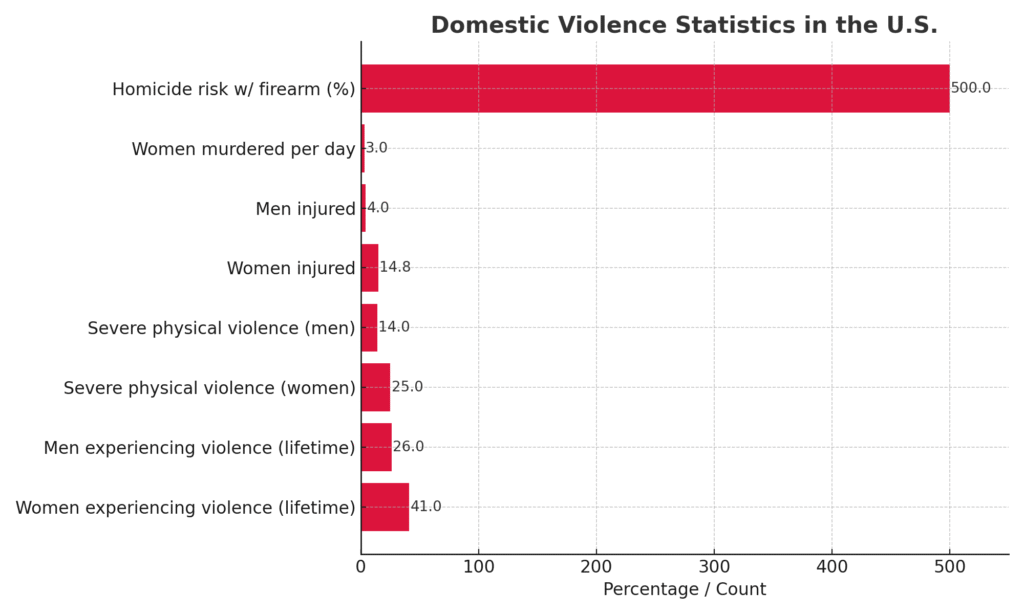
Every day in America, an epidemic is happening behind closed doors.
It’s not on your nightly news. It’s not trending on social media.
But it is killing more people than you think — and destroying millions more in ways that never make headlines.
Here’s the truth:
- Over 10 million adults in the U.S. are abused by an intimate partner every year.
- That’s 20 people every single minute — while you’ve been reading this sentence, another life just changed forever.
- Nearly 1 in 3 women and 1 in 4 men will experience severe violence, stalking, or sexual assault from a partner in their lifetime.
And yet, most Americans have no idea how deep this problem goes — or how much it costs us as a society.
What you’re about to read is the most comprehensive, fact-driven, no-BS guide to domestic violence in the United States available online.
Because if we’re going to stop this epidemic, we first have to understand it.
The Numbers You Can’t Ignore
If domestic violence were a disease, we’d call it a national emergency.
Here’s the scale of it in hard numbers — the kind that should be on billboards:
- 10 million people are abused by an intimate partner each year in the U.S.
- 20 people every minute experience physical abuse at the hands of a partner.
- 41% of women and 26% of men have endured contact sexual violence, physical violence, or stalking from a partner at some point in their lives.
- 1 in 4 women and 1 in 7 men have suffered severe physical violence from a partner — choking, beating, burning, or worse.
- Roughly 14.8% of women and 4% of men have been injured as a direct result of domestic violence.
- About 3 women are murdered every day by a current or former partner.
- The presence of a firearm in a domestic violence situation increases the risk of homicide by 500%.
These aren’t just statistics.
They are your neighbors, your co-workers, your family members.
Most will never tell you what they’ve been through.
The Hidden Costs No One Talks About
Domestic violence doesn’t just leave bruises.
It leaves scars you can’t see — and a price tag you can’t imagine.
The Psychological Toll
- Nearly half of U.S. adults report experiencing psychological aggression from a partner at some point.
- That’s not just “harsh words” — it’s patterns of humiliation, threats, manipulation, and control that chip away at a person’s self-worth.
- The CDC estimates 61 million women and 53 million men in America have experienced psychological aggression in their lifetime.
- Survivors often develop PTSD, depression, anxiety disorders, and in some cases, suicidal thoughts.
The Physical Toll
- Severe injuries include broken bones, traumatic brain injuries, internal bleeding, and chronic pain that can last a lifetime.
- Domestic violence is a leading cause of injury for women — more common than car accidents, muggings, and stranger rapes combined.
- When a gun is present, a domestic dispute is five times more likely to turn deadly.
The Financial Toll
- The lifetime cost for a single female survivor averages $103,767.
- For male survivors, it’s about $23,414.
- These costs include healthcare, lost wages, property damage, legal expenses, and mental health treatment.
- On a national scale, the price tag reaches $3.6 trillion — money drained from healthcare systems, workplaces, and taxpayer-funded programs.
The reality?
Domestic violence isn’t just a “private issue.”
It’s a public health crisis and an economic drain that touches every single taxpayer, whether they realize it or not.
Who Faces the Greatest Risk
Domestic violence doesn’t discriminate — but some groups face it more often and more severely than others.
Women
- Women experience domestic violence at higher rates than men, especially severe forms like choking, sexual assault, and life-threatening injuries.
- 1 in 3 women will experience severe physical violence, sexual violence, or stalking from a partner in their lifetime.
- Homicide risk is particularly high: almost half of all female murder victims are killed by current or former partners.
Men
- Often overlooked, men make up about 1 in 4 victims of intimate partner violence.
- Stigma and social perceptions make it harder for male victims to report abuse or seek help — leading to chronic underreporting.
- Emotional abuse, financial control, and false accusations are some of the most common forms men face.
Teens and Young Adults
- Violence often starts young — millions of Americans first experience abuse before age 18.
- Teen dating violence includes physical harm, sexual pressure, and digital abuse (threatening messages, controlling access to social media).
- Abusive patterns in young relationships can set the stage for future abusive partnerships if not addressed.
Marginalized Groups
- LGBTQ+ individuals often face higher rates of domestic violence than heterosexual couples, compounded by unique barriers to accessing support.
- Immigrants may avoid reporting abuse due to language barriers, cultural pressure, or fear of deportation.
- People with disabilities are at significantly higher risk — sometimes targeted because of their physical or cognitive vulnerabilities.
This isn’t just about isolated cases — it’s about patterns, vulnerabilities, and systems that allow abuse to thrive.
And the deadly consequences aren’t just statistics; they’re daily realities.
When Abuse Turns Deadly
For some, domestic violence isn’t a long-term struggle — it’s the last chapter of their life.
The numbers here aren’t just tragic; they’re enraging.
The Death Toll
- On average, 3 women are murdered every day in the U.S. by a current or former intimate partner.
- In 2023 alone, there were 135 domestic violence–related homicides, a 17.4% increase from the previous year.
- Nearly half of all female homicide victims are killed by their partners.
The Firearm Factor
- The presence of a gun in a domestic violence situation increases the risk of homicide by 500%.
- Between 2020 and 2022, an average of 70+ women per month were shot and killed by intimate partners.
Beyond the Victim
- Domestic violence homicides often happen in front of children — leaving lifelong trauma.
- In some cases, abusers also target friends, family, or new partners of their ex, widening the circle of destruction.
Why These Deaths Keep Happening
- Restraining orders are violated in roughly half of all cases.
- Underreporting means police never even know a victim is in danger.
- Legal loopholes in some states still allow abusers with a history of violence to own firearms.
This is the grim endgame of abuse — and it’s entirely preventable.
The Lifetime Cost
- For a single survivor:
- $103,767 for women
- $23,414 for men
- This includes medical bills, lost wages, legal fees, mental health care, relocation costs, and repairing or replacing damaged property.
The National Bill
- The total cost of domestic violence in the U.S. is estimated at $3.6 trillion.
- Healthcare alone accounts for over $2 trillion of that.
- Productivity losses are staggering — about $12 billion every year from missed work, reduced performance, and long-term unemployment caused by trauma.
Who Pays
- Taxpayers fund emergency services, shelters, court systems, and public health programs.
- Businesses lose revenue from absenteeism and turnover.
- Families lose homes, savings, and stability — often falling into poverty after leaving an abusive partner.
Why the Cost Keeps Climbing
- Many survivors leave and return to abusive relationships multiple times (an average of seven attempts before leaving for good).
- Each cycle restarts the financial drain — for the survivor, their family, and the system.
Domestic violence doesn’t just break lives.
It quietly bleeds the economy dry — and everyone pays, whether they realize it or not.
The Silence That Keeps It Alive
If domestic violence is so widespread, why don’t we hear more about it?
The answer is simple — and deeply troubling: most victims don’t report it.
The Stigma Factor
- Survivors often fear being judged, blamed, or not believed.
- Men, in particular, face ridicule or disbelief if they admit they’ve been abused by a woman.
- Cultural and religious norms sometimes pressure victims to “keep family matters private,” even at the cost of their safety.
Fear of Escalation
- Many victims believe — often correctly — that leaving or reporting will make the abuse worse.
- Abusers may threaten to harm children, pets, or extended family members if the victim tries to leave.
Financial Dependence
- For survivors without independent income, leaving can mean homelessness or poverty.
- Abusers often control finances, making it harder for victims to save money or seek legal help.
Systemic Failures
- Restraining orders are often ignored — with minimal consequences for the abuser.
- Police response can be slow, dismissive, or biased, especially toward male victims or marginalized groups.
- In rural areas, shelters and resources may be hours away, with limited space or funding.
The result?
An epidemic that thrives in silence — allowing abusers to continue unchecked, often for years.
Breaking the Cycle: How to Fight Domestic Violence
Ending domestic violence isn’t just about punishing abusers — it’s about preventing abuse before it starts, supporting survivors, and creating a culture that refuses to look away.
1. Know the Warning Signs
Abuse often starts subtly:
- Extreme jealousy or possessiveness
- Controlling money, time, or friendships
- Constant criticism or humiliation
- Threats to harm themselves or others if you leave
Recognizing these early can save lives.
2. Support Survivors Without Judgment
- Believe them. Even if their story sounds unbelievable, abuse thrives on disbelief.
- Offer practical help — a place to stay, financial assistance, transportation.
- Respect their choices. Leaving is complex, and survivors know their situation best.
3. Use Your Voice
- Share accurate information and statistics.
- Challenge jokes, stereotypes, or comments that normalize abuse.
- Advocate for stronger protections and resources for victims in your community.
4. Donate and Volunteer
- Support local shelters, hotlines, and counseling services.
- Many organizations rely heavily on volunteers for everything from staffing crisis lines to organizing donation drives.
5. Remember This Hotline
National Domestic Violence Hotline
📞 1-800-799-SAFE (7233)
💬 Text “START” to 88788
🌐 thehotline.org
Confidential, 24/7, in over 200 languages.
Final Thought:
Domestic violence is not inevitable.
It’s a choice — and it’s preventable.
Every statistic you’ve read here is a life, a family, and a community affected.
The question isn’t if you can help — it’s how soon you’ll start.
Conclusion: The Epidemic We Can’t Afford to Ignore
Domestic violence is not rare. It’s not something that happens “over there” to “other people.”
It’s in your neighborhood. Your workplace. Your friend group.
And unless we shine a light on it, the cycle continues — silently, relentlessly, and at a cost that’s measured in both lives and billions.
You now have the numbers. You have the facts.
Share them. Talk about them. Act on them.
Because silence is the abuser’s best friend — and awareness is their greatest enemy.
